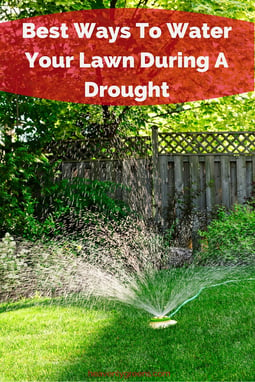 Keeping your lawn watered can be a difficult task if you live in areas that are prone to severe drought conditions. There are ways to help keep your lawn looking vibrant green, even in the driest of conditions. Although watering every day may be out of the question, homeowners have other options that provide modest amounts of moisture.
Keeping your lawn watered can be a difficult task if you live in areas that are prone to severe drought conditions. There are ways to help keep your lawn looking vibrant green, even in the driest of conditions. Although watering every day may be out of the question, homeowners have other options that provide modest amounts of moisture.
Make the Most of Gray Water
Gray water is the water that is left after washing dishes, laundry or taking a bath. Basically any leftover water, that is not full of soaps and conditioners. While it may not be suitable for human consumption, it is perfectly fine for watering plants, gardens and lawns as long as organic cleansers are used. Gray water does not need to be filtered and can be sprayed on the lawn with a hand sprayer or applied with small irrigation system.
Gray water can be collected and saved in barrels or water jugs until it is needed. In areas where water conservation is a must, it is important to save as much water as possible. First, use only what is needed and second, save what is left to be reused in other ways. Washing and rinsing dishes in small buckets or tubs keeps the water from going down the drain and allows you to easily save it for later use.
Aerate the Soil
Another way of keeping moisture close to the roots is to aerate the soil. Aerating the soil loosens the top few layers of dirt and allows both air and water to reach the roots. Avoid walking, driving or playing on grass if at all possible. Any impact that compresses the soil will slow the movement of water through the dirt. If the dirt is compacted too tightly, the water may not be able to penetrate it to reach the grass' roots. Aerating the soil every other week or so will keep the top soil loose enough to absorb any available moisture.
Plant Drought Resistant Grass
Seeding your lawn with drought resistant grass varieties is another way to conserve water. By planting grass varieties that do not need a lot of water, you will not have to irrigate the lawn as often. Using grasses that are native to the area and used to thriving on minimal amounts of water will help eliminate the need to break out the hose. Drought resistant plants also do well in extreme weather conditions. They can easily tolerate high temperatures as well as high levels of humidity.
Follow the Community Watering Schedule
Many communities, like those in California who have enacted laws pertaining to water wasting, have a schedule in place that tells homeowners when they can and cannot water their lawns. In some areas, homeowners are allowed to water their lawns once a week. In areas that are hardest hit, the schedule is suspended and no one is allowed to water their lawns at all until further notice.
When a schedule is in place, homeowners are given certain days when they can irrigate their lawns. They are allowed to run sprinklers and hoses for a set amount of time, depending on the severity of the conditions. Homeowners who violate the schedule by watering on days other than their own, can face large fines and have their watering privileges suspended indefinitely.
During drought conditions, it is difficult to water a lawn when there is little or no extra water to be had. There are things that a homeowner can do to maximize what little water is available and put it to use. Talking to landscaping professionals in your area will give you an accurate idea as to what you can do to keep your lawn looking fresh and green, even in the driest of conditions.











